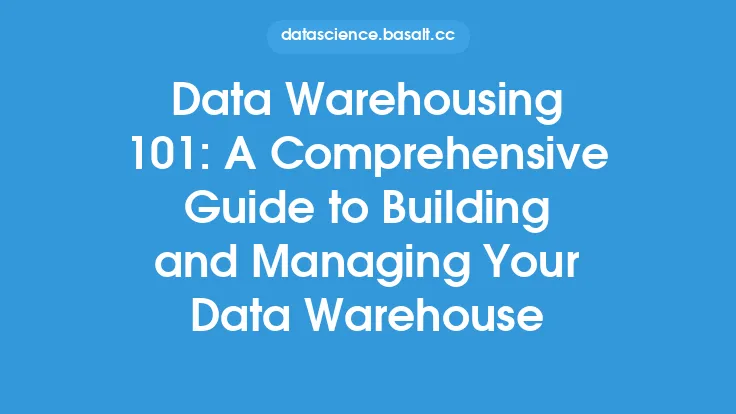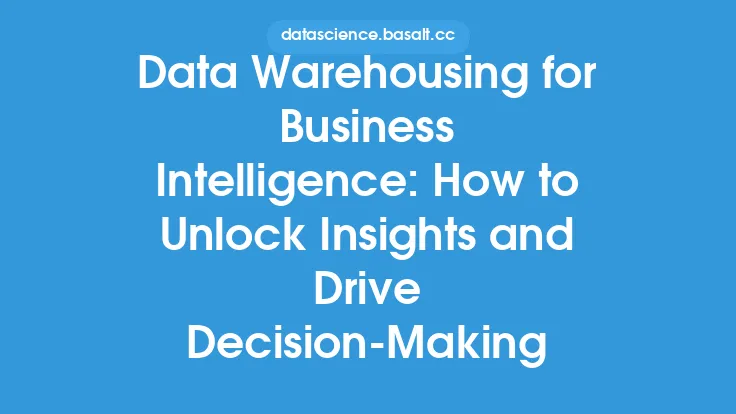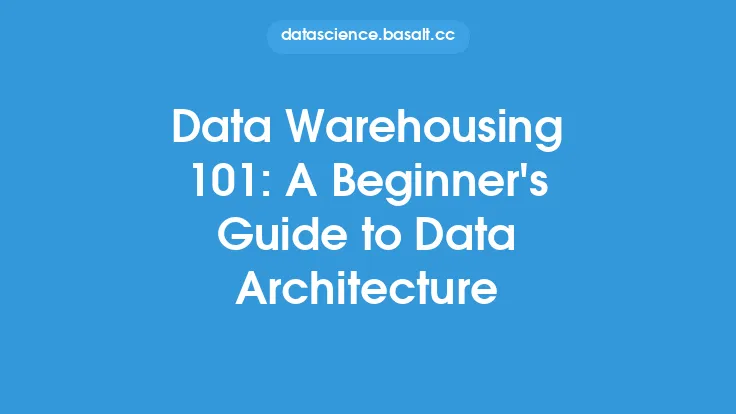Data warehousing is a crucial aspect of data engineering, and Extract, Transform, Load (ETL) is a key process in making data warehousing effective. ETL is the process of extracting data from multiple sources, transforming it into a standardized format, and loading it into a target system, such as a data warehouse. This process enables organizations to integrate data from various sources, ensure data consistency, and provide a unified view of the data.
Introduction to ETL
ETL is a critical component of data warehousing, as it allows organizations to extract data from various sources, transform it into a standardized format, and load it into a data warehouse. The ETL process involves three main stages: extract, transform, and load. The extract stage involves collecting data from multiple sources, such as databases, files, and applications. The transform stage involves converting the extracted data into a standardized format, which includes data cleaning, data mapping, and data aggregation. The load stage involves loading the transformed data into the target system, such as a data warehouse.
ETL Tools and Technologies
There are various ETL tools and technologies available, including open-source and commercial options. Some popular ETL tools include Informatica PowerCenter, Microsoft SQL Server Integration Services (SSIS), and Talend. These tools provide a range of features, such as data integration, data transformation, and data loading. They also support various data sources, including relational databases, flat files, and big data platforms. Additionally, cloud-based ETL tools, such as Amazon Web Services (AWS) Glue and Google Cloud Dataflow, are gaining popularity, as they provide scalability, flexibility, and cost-effectiveness.
ETL Process
The ETL process involves several steps, including data extraction, data transformation, and data loading. Data extraction involves collecting data from multiple sources, using techniques such as database queries, file reads, and API calls. Data transformation involves converting the extracted data into a standardized format, using techniques such as data mapping, data aggregation, and data cleaning. Data loading involves loading the transformed data into the target system, using techniques such as bulk loading, incremental loading, and real-time loading.
Data Transformation
Data transformation is a critical stage of the ETL process, as it involves converting the extracted data into a standardized format. Data transformation involves several techniques, including data mapping, data aggregation, and data cleaning. Data mapping involves mapping the source data to the target data, using techniques such as data type conversion and data format conversion. Data aggregation involves aggregating the data, using techniques such as grouping, sorting, and filtering. Data cleaning involves cleaning the data, using techniques such as data validation, data normalization, and data deduplication.
Data Loading
Data loading is the final stage of the ETL process, as it involves loading the transformed data into the target system. Data loading involves several techniques, including bulk loading, incremental loading, and real-time loading. Bulk loading involves loading large amounts of data into the target system, using techniques such as batch processing and parallel processing. Incremental loading involves loading small amounts of data into the target system, using techniques such as change data capture and incremental updates. Real-time loading involves loading data into the target system in real-time, using techniques such as streaming data integration and event-driven architecture.
ETL Best Practices
There are several best practices to follow when implementing ETL, including data quality management, data governance, and data security. Data quality management involves ensuring the accuracy, completeness, and consistency of the data, using techniques such as data validation, data normalization, and data deduplication. Data governance involves managing the data, using techniques such as data ownership, data stewardship, and data compliance. Data security involves securing the data, using techniques such as data encryption, data access control, and data auditing.
ETL Challenges
There are several challenges associated with ETL, including data complexity, data volume, and data variety. Data complexity involves dealing with complex data structures, such as hierarchical and relational data. Data volume involves dealing with large amounts of data, using techniques such as data partitioning, data sampling, and data aggregation. Data variety involves dealing with different data formats, such as structured, semi-structured, and unstructured data.
Conclusion
In conclusion, ETL is a critical component of data warehousing, as it enables organizations to integrate data from various sources, ensure data consistency, and provide a unified view of the data. The ETL process involves several stages, including data extraction, data transformation, and data loading. There are various ETL tools and technologies available, including open-source and commercial options. Additionally, there are several best practices to follow when implementing ETL, including data quality management, data governance, and data security. By following these best practices and using the right ETL tools and technologies, organizations can overcome the challenges associated with ETL and achieve their data warehousing goals.





